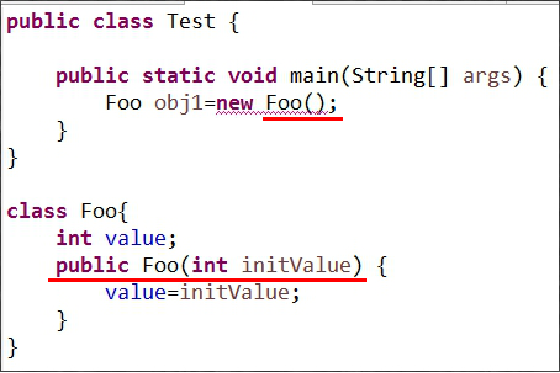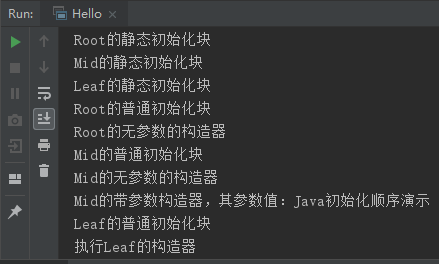这次动手动脑,我学到了多个构造函数的顺序和相互调用,


比如这个程序运行结果如下,由此我们知道,如果类里面自己定义了一个构造函数;系统将不会默认给出构造函数供主函数调用。
1 package hello; 2 3 public class Hello { 4 public int value=200; 5 { 6 value =100; 7 } 8 9 public Hello() { 10 this.value = 300; 11 } 12 13 public static void main(String[] args) { 14 Hello hello=new Hello(); 15 System.out.println("初始化值为="+hello.value); 16 } 17 }

这是个初始化调用的问题,由运行结果我们可知道,系统会先调用构造函数,初始化数据。
3、
1 class Root 2 { 3 static{ 4 System.out.println("Root的静态初始化块"); 5 } 6 7 { 8 System.out.println("Root的普通初始化块"); 9 } 10 public Root() 11 { 12 System.out.println("Root的无参数的构造器"); 13 } 14 } 15 class Mid extends Root 16 { 17 static{ 18 System.out.println("Mid的静态初始化块"); 19 } 20 { 21 System.out.println("Mid的普通初始化块"); 22 } 23 public Mid() 24 { 25 System.out.println("Mid的无参数的构造器"); 26 } 27 public Mid(String msg) 28 { 29 //通过this调用同一类中重载的构造器 30 this(); 31 System.out.println("Mid的带参数构造器,其参数值:" + msg); 32 } 33 } 34 class Leaf extends Mid 35 { 36 static{ 37 System.out.println("Leaf的静态初始化块"); 38 } 39 40 { 41 System.out.println("Leaf的普通初始化块"); 42 } 43 44 public Leaf() 45 { 46 //通过super调用父类中有一个字符串参数的构造器 47 super("Java初始化顺序演示"); 48 System.out.println("执行Leaf的构造器"); 49 } 50 51 } 52 53 public class TestStaticInitializeBlock 54 { 55 public static void main(String[] args) 56 { 57 new Leaf(); 58 59 60 } 61 }

编译顺序是,在构建子类对象时,先构建父类的对象,之后一次执行相应的静态语句块,然后依次执行相应的普通语句块和构造函数,当在子类中有super();时,分类的构造函数使用super();调用的父类构造函数。